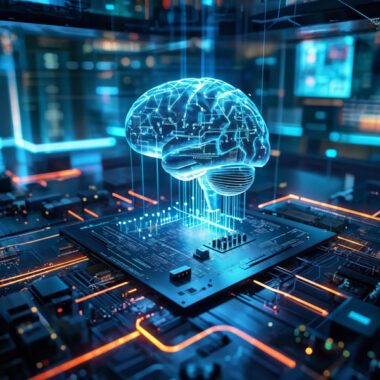Summary: Deep Learning vs Neural Network is a common comparison in the field of artificial intelligence, as the two terms are often used interchangeably. However, they differ in complexity and application. Neural Networks are foundational structures, while Deep Learning involves complex, layered networks like CNNs and RNNs, enabling advanced AI capabilities such as image recognition and natural language processing.
Introduction
Deep Learning and Neural Networks are like a sports team and its star player. Just as a team relies on its players, Deep Learning relies on Neural Networks as its foundational component. However, Deep Learning is the entire strategy, involving complex layers and architectures like CNNs and RNNs, which enable advanced AI capabilities.
This analogy highlights how Neural Networks are the building blocks, while Deep Learning is the comprehensive approach that leverages these blocks to achieve sophisticated tasks like image recognition and natural language processing.
The terms “neural network” and “Deep Learning” are often used interchangeably, leading to confusion. While deeply related, they are distinct concepts. This post covers Deep Learning vs Neural Network to clarify the differences and explore their key features.
Key Takeaways:
- Neural Network Basics: Foundational structure for Machine Learning models.
- Deep Learning Complexity: Involves multiple layers for advanced AI tasks.
- Application Differences: Neural Networks for simple tasks, Deep Learning for complex ones.
- Layered Architectures: Deep Learning uses CNNs, RNNs, and more.
- AI Capabilities: Enables image recognition, NLP, and predictive analytics.
Neural Networks: The Foundation
A neural network is a computing system inspired by the biological neural networks that constitute animal brains. It’s composed of interconnected nodes (“neurons”) organized in layers:
- Input Layer: Receives the initial data (e.g., pixels in an image, words in a sentence).
- Hidden Layers: Perform computations on the input data. These layers extract features and patterns from the input. The more hidden layers, the more complex the patterns that can be learned.
- Output Layer: Produces the final result (e.g., classification of the image, translation of the sentence).
Each connection between neurons has an associated weight, representing the strength of the connection. The network learns by adjusting these weights based on the input data and desired output.
This process, called training, involves feeding the network with examples and iteratively modifying the weights to minimize the difference between the predicted output and the actual output. This is achieved through algorithms like backpropagation.
Simple neural networks with a few hidden layers can solve relatively simple problems. However, they struggle with complex tasks requiring the extraction of intricate features and relationships within the data.
Deep Learning: The Deeper Dive
Deep Learning is a subfield of Machine Learning that uses artificial neural networks with multiple layers (hence “deep”). The “depth” is crucial; it allows the network to learn hierarchical representations of data.
In other words, it learns simpler features in the early layers, and then combines those features to learn more complex features in subsequent layers. This hierarchical approach enables Deep Learning models to handle highly complex data and tasks.
Here’s how it works:
- Feature Extraction: The initial layers learn basic features from the raw input data. For example, in image recognition, early layers might detect edges and corners.
- Hierarchical Feature Learning: Subsequent layers combine these basic features to learn more complex features, like shapes and textures.
- High-Level Representation: The final layers combine these complex features to represent the entire input at a high level of abstraction, allowing for accurate classification or prediction.
The depth of a Deep Learning network allows it to automatically learn intricate features without explicit feature engineering, which is a significant advantage over traditional Machine Learning methods.
Table Showing Deep Learning vs Neural Network
Types of Deep Learning Architectures
Deep Learning models are essentially Artificial Neural Networks (ANNs) with multiple layers (hence “deep”). The architecture refers to the specific way these layers are structured, connected, and the types of operations they perform.
The choice of architecture is crucial because it dictates how the model processes information and learns representations from the data. Different architectures excel at different tasks, like understanding images, processing sequences, or generating new data. Here are some of the most common and influential Deep Learning architectures:
Feedforward Neural Networks (FNNs) / Multi-Layer Perceptrons (MLPs)
The simplest type of ANN. Information flows in only one direction – from the input layer, through one or more hidden layers, to the output layer. There are no loops or cycles. Each neuron in a layer is typically connected to every neuron in the subsequent layer (fully connected).
- Key Features: Input, Hidden, and Output layers; Fully connected layers; Activation functions (like ReLU, Sigmoid, Tanh).
- Use Cases: Basic classification and regression tasks, tabular Data Analysis, foundational component in more complex architectures.
- Strengths: Simple to understand and implement, good baseline model.
- Limitations: Don’t handle sequential or spatial dependencies well; struggle with high-dimensional data like images directly (requires flattening, losing spatial info).
- Image Reference Idea: A simple diagram showing nodes arranged in vertical layers (Input, Hidden, Output) with arrows pointing strictly from left to right, connecting all nodes in one layer to all nodes in the next.
- Search term example: “Feedforward Neural Network diagram” or “Multi-Layer Perceptron architecture”
Convolutional Neural Networks (CNNs or ConvNets)
Specifically designed to process grid-like data, such as images. CNNs use special layers called convolutional layers that apply filters (kernels) across the input data to detect spatial hierarchies of features (edges, textures, patterns, objects).
- Key Features:
- Convolutional Layers: Apply filters to detect features. Utilize parameter sharing and local connectivity.
- Pooling Layers (e.g., MaxPooling): Reduce the spatial dimensions (downsampling), making the model more robust to variations in feature location and reducing computation.
- Activation Functions (often ReLU): Introduce non-linearity.
- Fully Connected Layers: Often used at the end to perform classification based on the extracted features.
- Use Cases: Image recognition, object detection, image segmentation, computer vision tasks, medical image analysis, can also be adapted for NLP (text classification).
- Strengths: Excellent performance on spatial data, translation invariance (can detect an object regardless of its position), parameter sharing makes them efficient.
- Limitations: Primarily designed for grid-like input.
Recurrent Neural Networks (RNNs)
Designed to handle sequential data where order matters, like text or time series. RNNs have connections that form cycles, allowing information from previous steps in the sequence to persist and influence the processing of current steps – they have a “memory”.
- Key Features: Recurrent connections (loops), hidden state that carries information through time steps.
- Use Cases: Natural Language Processing (NLP) (language modeling, machine translation, sentiment analysis), speech recognition, time series prediction, video analysis.
- Strengths: Can process inputs of variable length, captures temporal dependencies.
- Limitations: Suffer from vanishing/exploding gradient problems (difficulty learning long-range dependencies), computation can be slow as it’s inherently sequential.
Long Short-Term Memory (LSTM) and Gated Recurrent Unit (GRU)
These are special types of RNNs designed specifically to overcome the vanishing gradient problem and learn long-range dependencies more effectively. They use “gates” – specialized mechanisms that control the flow of information, deciding what to remember, what to forget, and what to output.
- Key Features:
- LSTM: Uses three gates (Input, Forget, Output) and a cell state to manage memory.
- GRU: A simpler variant with two gates (Update, Reset) and no separate cell state, often performing comparably to LSTMs with fewer parameters.
- Use Cases: Same as RNNs, but generally preferred for tasks requiring capturing longer context (e.g., complex language translation, long sequence generation).
- Strengths: Effectively capture long-range dependencies, mitigate vanishing gradients.
- Limitations: More complex than simple RNNs.
Transformers
Introduced in the paper “Attention Is All You Need”. Transformers rely entirely on self-attention mechanisms instead of recurrence or convolution (in their core design) to draw global dependencies between inputs and outputs. They process sequence data in parallel.
- Key Features:
- Self-Attention / Multi-Head Attention: Allows the model to weigh the importance of different words/tokens in the input sequence when processing a specific word/token.
- Positional Encoding: Since there’s no recurrence, information about the position of tokens in the sequence is explicitly added.
- Encoder-Decoder Structure: Common for sequence-to-sequence tasks (like translation), though encoder-only (e.g., BERT) and decoder-only (e.g., GPT) variants are very popular.
- Use Cases: State-of-the-art in many NLP tasks (translation, text summarization, question answering, text generation – BERT, GPT models are Transformer-based), increasingly used in computer vision (Vision Transformers – ViT).
- Strengths: Excellent at capturing long-range dependencies, highly parallelizable (leading to faster training on modern hardware), current SOTA for many tasks.
- Limitations: Computationally intensive (attention complexity is quadratic with sequence length, though alternatives exist), can require large datasets, less inherently biased towards local structure than CNNs (which can be good or bad depending on the task).
Autoencoders (AEs)
An unsupervised learning architecture used primarily for dimensionality reduction and feature learning. An Autoencoder consists of two parts: an Encoder that compresses the input into a low-dimensional latent representation (bottleneck), and a Decoder that reconstructs the original input from this latent representation.
- Key Features: Encoder network, Bottleneck layer (latent space), Decoder network, Reconstruction loss (e.g., Mean Squared Error) comparing input and output.
- Use Cases: Dimensionality reduction, data denoising, anomaly detection, feature extraction, pre-training for supervised tasks. Variations include Denoising AEs, Sparse AEs, Variational AEs (VAEs – generative).
- Strengths: Unsupervised learning (doesn’t require labeled data), learns compact data representations.
- Limitations: Primarily focused on reconstruction, the learned latent space might not always be easily interpretable or optimal for downstream tasks without specific constraints (like in VAEs).
Generative Adversarial Networks (GANs)
A generative model framework where two neural networks compete against each other. The Generator network tries to create realistic data (e.g., images) from random noise, while the Discriminator network tries to distinguish between real data and the fake data created by the Generator. They are trained together in a zero-sum game.
- Key Features: Generator network, Discriminator network, Adversarial loss function.
- Use Cases: Realistic image generation, style transfer, data augmentation, super-resolution, drug discovery.
- Strengths: Can generate highly realistic and novel data samples.
- Limitations: Training can be unstable and difficult (mode collapse, non-convergence), evaluating the quality of generated samples can be challenging.
Conclusion
While the debate on Deep Learning vs Neural Network is valid, we also would like to mention that all Deep Learning models are neural networks, not all neural networks are Deep Learning models. Deep Learning represents a significant advancement, enabling the solution of complex problems previously intractable with simpler neural networks.
The choice between a simple neural network and a Deep Learning model depends on the complexity of the task, the availability of data, and the computational resources available. As the field continues to advance, we can anticipate even more sophisticated and powerful Deep Learning architectures and applications in the future.
Frequently Asked Questions
How Does Deep Learning Differ from Neural Networks?
Deep Learning uses multiple layers of Neural Networks to perform complex tasks, unlike simple Neural Networks.
What are the Applications of Deep Learning?
Deep Learning is used in image recognition, natural language processing, and predictive analytics.
Is Deep Learning A Type of Neural Network?
Yes, Deep Learning is a subset of Neural Networks, focusing on complex, layered architectures.




